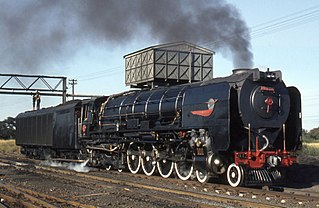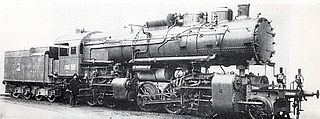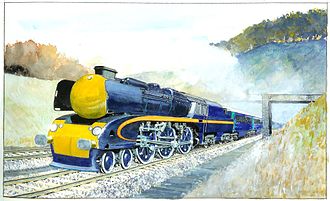
A steam locomotive is a locomotive that provides the force to move itself and other vehicles by means of the expansion of steam. It is fuelled by burning combustible material to heat water in the locomotive's boiler to the point where it becomes gaseous and its volume increases 1,700 times. Functionally, it is a steam engine on wheels.
In railway engineering, the term tractive effort describes the pulling or pushing capability of a locomotive. The published tractive force value for any vehicle may be theoretical—that is, calculated from known or implied mechanical properties—or obtained via testing under controlled conditions. The discussion herein covers the term's usage in mechanical applications in which the final stage of the power transmission system is one or more wheels in frictional contact with a railroad track.
Rail transport terms are a form of technical terminology applied to railways. Although many terms are uniform across different nations and companies, they are by no means universal, with differences often originating from parallel development of rail transport systems in different parts of the world, and in the national origins of the engineers and managers who built the inaugural rail infrastructure. An example is the term railroad, used in North America, and railway, generally used in English-speaking countries outside North America and by the International Union of Railways. In English-speaking countries outside the United Kingdom, a mixture of US and UK terms may exist.

The valve gear of a steam engine is the mechanism that operates the inlet and exhaust valves to admit steam into the cylinder and allow exhaust steam to escape, respectively, at the correct points in the cycle. It can also serve as a reversing gear. It is sometimes referred to as the "motion".

Main components found on a typical steam locomotive include:

The GWR 4100 Class was a class of steam locomotives in the Great Western Railway (GWR) of the United Kingdom.

Livio Dante Porta was an Argentine steam locomotive engineer. He is particularly remembered for his innovative modifications to existing locomotive systems in order to obtain better performance and energy efficiency, and reduced pollution. He developed the Kylpor and Lempor exhaust systems. The Lemprex was under development at the time of his death.
Engine balance refers to how the inertial forces produced by moving parts in an internal combustion engine or steam engine are neutralised with counterweights and balance shafts, to prevent unpleasant and potentially damaging vibration. The strongest inertial forces occur at crankshaft speed and balance is mandatory, while forces at twice crankshaft speed can become significant in some cases.

British Railways Standard Class 5 No. 73096 is a preserved British steam locomotive, unnamed in service. It has spent most of its time in preservation in the care of the Watercress Line.

The South African Railways Class 26 4-8-4 of 1981, popularly known as the Red Devil, is a 4-8-4 steam locomotive which was rebuilt from a Class 25NC locomotive by mechanical engineer David Wardale from England while in the employ of the South African Railways. The rebuilding took place at the Salt River Works in Cape Town and was based on the principles developed by Argentinian mechanical engineer L.D. Porta.

The South African Railways Class 25NC 4-8-4 of 1953 was a class of steam locomotives built between 1953 and 1955 for the South African Railways (SAR). The Class 25NC was the non-condensing version of the Class 25 condensing locomotive, of which ninety were placed in service at the same time. Between 1973 and 1980, all but three of the condensing locomotives were converted to non-condensing and also designated Class 25NC.

The South African Railways Class 25 4-8-4 of 1953 was a condensing steam locomotive.

The ČSD Class 387.0 were 4-6-2 express passenger steam locomotives operated by the Czechoslovak State Railways between 1926 and 1974. Forty-three of these 2,100-horsepower (1,570 kW) pacific locomotives were built by the Škoda Works, Plzeň in five series between 1926 and 1937, intended for the heaviest long-distance express trains.
The South African Railways Class GA 2-6-0+0-6-2 of 1921 was an articulated steam locomotive.

The South African Railways Class GM 4-8-2+2-8-4 of 1938 was an articulated steam locomotive.

A steam motor is a form of steam engine used for light locomotives and light self-propelled motor cars used on railways. The origins of steam motor cars for railways go back to at least the 1850s, if not earlier, as experimental economizations for railways or railroads with marginal budgets. These first examples, at least in North America, appear to have been fitted with light reciprocating engines, and either direct or geared drives, or geared-endless chain drives. Most incorporated a passenger carrying coach attached to the engine and its boiler. Boiler types varied in these earlier examples, with vertical boilers dominant in the first decade and then with very small diameter horizontal boilers. Other examples of steam motor cars incorporated an express-baggage or luggage type car body, with coupling apparatus provided to allow the steam motor car to draw a light passenger coach.

The Central South African Railways Rack 4-6-4RT of 1905 was a South African steam locomotive from the pre-Union era in Transvaal Colony.

The MÁV class 601 was a class of Hungarian four-cylinder Mallet locomotives, which was designed to haul long and very heavy cargo on very steep railway tracks. At 22.5 m long and outputting 2,200 kW (3,000 hp), they were the largest and most powerful steam locomotives built in Europe before and during World War I.
Locomotive 51 of the Limburgsche Tramweg Maatschappij was a Garratt locomotive. It was the only Garratt type locomotive in the Netherlands. The locomotive was designed for operation on the line Maastricht - Vaals, which required a locomotive with at least 5 coupled axles. A conventional locomotive of this size would experience too much rolling resistance in the many curves on this line, which were typical tramway curves of small radius.
The Midland Railway 2601 class was the last of four classes of 4-2-2 steam locomotives designed by Samuel Johnson for the Midland Railway. They were a development of his 115 class Spinners.















